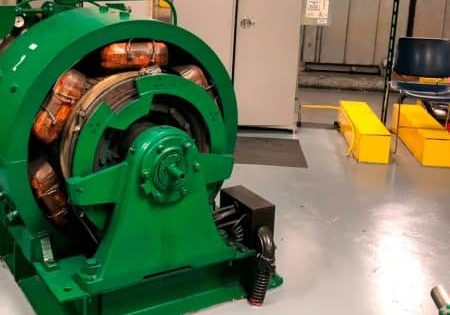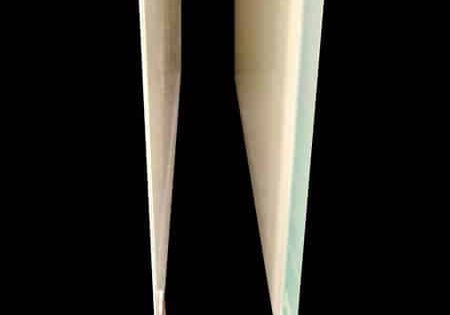Following these important rules will help ensure safe operation and aid elevator diagnostics.
This article is approved for Continuing Education by NAEC for CET® and CAT®. EW Continuing Education is currently approved in the following states: AL, AR, FL, GA, IL, IN, KY, MD, MO, MS, MT, OK, PA, VA, VT, WV and WI. Please check for specific course verification of approval at www.elevatorbooks.com.
The American Society of Mechanical Engineers (ASME), through its Board of Safety Codes and Standards, develops and maintains a comprehensive portfolio of mandates that govern existing elevators and escalators. A complete listing can be seen at ASME.org.
ASME A17.3: Safety Code for Existing Elevators and Escalators is an essential reference for elevator maintenance workers, repair technicians and manufacturers. It can be ordered online at the ASME website and www.elevatorbooks.com.
Learning Objectives
After reading this article, you should have learned about:
♦ Traction elevator safety mechanisms
♦ The relation between the elevator motion
controller and sensors
♦ Gathering information prior to elevator fault diagnosis
♦ How the motor and brake respond to fault signals
♦ How door interlock status is conveyed to the motion controller
Driving Machines and Sheaves
As a basis for understanding elevator motion controllers, associated sensors and wiring, Section 3.8 Driving Machines and Sheaves lays out some pertinent provisions. Section 3.8.1 General Requirements provides that sheaves and drums are to be made of cast iron or steel with finished grooves for ropes. (In referring to ropes, of course, steel ropes are meant.):
“Set screw fastenings are not to be used in lieu of keys or pins on connections subject to torque or tension. Friction gearing or a clutch mechanism is not to be used to connect a driving mechanism, other than in connection with a car leveling device.”
Section 3.8.2 Winding Drum Machines provides that these machines are to be provided with a slack-rope device having an enclosed switch of the manually reset type that will cause the electric power to be removed from the elevator driving machine motor and brake if the hoisting ropes become slack or broken.
Final terminal stopping devices for winding drum machines are to consist of stopping switches, both on the driving machine and in the hoistway, and operated by cams attached to the car. Those on the driving machine are not to be driven by chains, ropes or belts. The opening of these contacts is to occur before or coincident with the opening of the final terminal stopping switch.
Where a three-phase AC driving-machine motor is used, the mainline circuit to the driving-machine brake coils are to be directly opened, either by the contacts of the machine stop switch or by stopping switches mounted in the hoistway and operated by a cam attached to the car.
Driving machines equipped with a DC motor and DC brake are permitted to have the final terminal stopping device contacts installed in the operating circuits. The occurrence of a single ground or failure of any single magnetically operated switch, contactor or relay must not render any final terminal stopping device ineffective.
Section 3.8.4 Brakes provides that:
“The elevator driving machine is to be equipped with a friction brake applied by a spring or springs, or by gravity, and released electrically. The brake is to have a capacity sufficient to hold the car at rest with its rated load. For passenger elevators and freight elevators permitted to carry employees, the brake is to be designed to hold the car at rest with an additional load up to 25% in excess of the rated load.”
Terminal Stopping Devices
Section 3.9 Terminal Stopping Devices states that enclosed:
“. . .upper and lower normal stopping devices are to be provided and arranged to slow down and stop the car automatically at or near the top and bottom terminal landings. Such devices are to function independently of the operation of the normal stopping means and of the final terminal stopping device.
“Normal stopping devices are to be located on the car, in the hoistway or in the machine room, and are to be operated by the movement of the car.
“Broken rope, tape or chain switches are to be provided in connection with normal stopping devices located in the machine room of traction elevators. Such switches are to be opened by a failure of the rope, tape or chain and are to cause the electrical power to be removed from the driving-machine motor and brake.” Section 3.9.2 Final Terminal Stopping Devices states:
“Enclosed upper and lower final terminal electromechanical stopping devices are to be provided and arranged to prevent movement of the car by the normal operating devices in either direction of travel after the car has passed a terminal landing. Final terminal stopping devices are to be located as follows:
“Elevators having winding drum machines are to have stopping switches on the machines and also in the hoistway operated by the movement of the car. Elevators having traction- driving machines are to have stopping switches in the hoistway operated by the movement of the car.”
Electrical Protective Devices
Section 3.10.4 Electrical Protective Devices states that these devices are to be protected as follows:
- “(a) Slack-Rope Switch. Winding drum machines are to be provided with a slack-rope device equipped with a slack rope switch of the enclosed manually reset type that will cause the electric power to be removed from the elevator driving-machine motor and brake if the suspension ropes become slack.
- (b) Motor-Generator Running Switch. Where generator-field control is used, means are to be provided to prevent the application of power to the elevator driving machine motor and brake unless the motor-generator set connections are properly switched for the running condition of the elevator. It is not required that the electrical connections between the elevator driving-machine motor and the generator be opened in order to remove power from the elevator motor.
- (c) Compensating Rope Sheave Switch. Compensating rope sheaves are to be provided with a compensating rope sheave switch or switches mechanically opened by the compensating rope sheave before the sheave reaches its upper or lower limit of travel to cause the electric power to be removed from the elevator driving-machine motor and brake.
- (d) Broken Rope, Tape or Chain Switches Used in Connection with Machine Room Normal Stopping Switches. Broken rope, tape or chain switches are to be provided in connection with normal terminal stopping devices located in machine rooms of traction elevators. Such switches are to be opened by failure of the rope, tape or chain.
- (e) Stop Switch on Top of Car. A stop switch is to be provided on the top of every elevator car, which will cause the electric power to be removed from the elevator driving-machine motor and brake. It is to be of the manually operated and closed type with red operating handles or buttons. It is to be conspicuously and permanently marked ‘STOP’ and indicate the stop and run positions. It is to be positively opened mechanically, opening not solely dependent on springs.
- (f) Car Safety Mechanism Switch. A switch is required where a car safety is provided.
- (g) Speed Governor Overspeed Switch. Where required by Section 3.6.1, a speed governor overspeed switch is to be provided.
- (h) Final Terminal Stopping Device. Where reduced stroke oil buffers are provided, final terminal stopping devices are to be provided.
- (i) Emergency Terminal Speed Limiting Device. Where reduced stroke oil buffers are provided, emergency terminal speed limiting devices are required.
- (j) Motor Generator Overspeed Protection. Means are to be provided to cause the electric power to be removed automatically from the elevator driving-machine motor and brake, should a motor generator overspeed excessively.
- (k) Motor Field Sensing Means. Where DC is supplied to an armature and shunt field of an elevator driving-machine motor, a motor-field current sensing means is to be provided, which will cause the electric power to be removed from the motor armature and brake unless current is flowing in the shunt field of the motor. A motor-field current sensing means is not required for static control elevators provided with a device to detect an overspeed condition prior to, and independent of, the operation of the governor overspeed switch. This device must cause power to be removed from the elevator driving-machine motor armature and machine brake.
- (l) Buffer Switches for Oil Buffers Used with Type C Car Safeties. Oil level and compression switches are to be provided for all oil buffers used with Type C safeties.
- (m) Hoistway Door Interlocks or Hoistway Door Electric Contacts. Hoistway door interlocks of hoistway door electric contacts are to be provided for all elevators.
- (n) Car Door or Gate Electric Contacts. Car door or gate electric contacts are to be provided for all elevators.
- (o) Normal Terminal Stopping Devices. Normal terminal stopping devices are to be provided for every elevator.
- (p) Car Side Emergency Exit Electric Contact. An electric contact is to be provided on every car side emergency exit door.
- (q) Electric Contacts for Hinged Car Platform Sills. Where provided, hinged car platform sills are to be provided with electric contacts.
- (r) In-Car Stop Switch. On passenger elevators equipped with nonperforated enclosures, a stop switch, either key-operated or behind a locked cover, is permitted to be provided in the car and located in or adjacent to the car operating panel. The switch is to be clearly and permanently marked ‘STOP’ and is to indicate the stop and run positions. The switch is to be positively opened mechanically and its opening is not to be solely dependent on springs. When opened, this switch is to cause the electric power to be removed from the elevator driving-machine motor and brake.
- (s) Emergency Stop Switch. On all freight elevators, passenger elevators with perforated enclosures and passenger elevators with nonperforated enclosures not provided with an in-car stop switch, an emergency stop switch is to be provided in the car and located in or adjacent to each car operating panel. When open (‘STOP’ position), this switch is to cause the electric power to be removed from the elevator driving-machine motor and brake and is to:
- (1) be of the manually operated and closed type.
- (2) have red operating handles or buttons.
- (3) be conspicuously and permanently marked ‘STOP’ and is to indicate the stop and run positions.
- (4) have contacts that are positively opened mechanically (opening not solely dependent on springs).
- (t) Stop Switch in Pit. A stop switch conforming to (e) Stop Switch on Top of Car is to be provided in the pit of every elevator. The switch is to be adjacent to every pit access.
- (u) Buffer Switches for Gas Spring Return Oil Buffers. A buffer switch is to be provided for gas spring return oil buffers that will cause electric power to be removed from the elevator
driving-machine motor and brake if the plunger is not within 0.5 inches of the fully extended position.”
Power Supply Disconnecting Means and Protection
Section 3.10.5 Power Supply Disconnecting Means provides that:
- “(a) A disconnect switch or a circuit breaker is to be installed and connected into the power supply line to each elevator motor or motor generator set and controller. The power supply line is to be provided with over-current protection, preferably inside the machine room.
- (b) The disconnect switch or circuit breaker is to be of the manually closed multipole type, and is to be visible from the elevator driving machine or motor generator set. When the disconnecting means is not within sight of the driving machine, the control panel or the motor-generator set, an additional manually operated switch is to be installed adjacent to the remote equipment and connected to the control circuit to prevent starting.
- (c) No provision is to be made to close the disconnect switch from any other part of the building.
- (d) Where there is more than one driving machine in a machine room, disconnect switches or circuit breakers are to be numbered to correspond to the number of the driving machine that they control.”
Section 3.10.6 Phase Reversal and Failure Protection states:
“Elevators having polyphase AC power supplies are to be provided with means to prevent the starting of the elevator motor if the phase rotation is in the wrong direction or if there is a failure of any phase. This protection is considered to be provided in the case of generator field control having AC motor-generator driving motors, provided a reversal of phase will not cause the elevator driving machine motor to operate in the wrong direction. Controllers on which switches are operated by polyphase torque motors provide inherent protection against phase reversal or failure.”
Hoistway Door Specifications
Section 3.10.7 Operating of the Driving Machine With a Hoistway Door Unlocked or a Hoistway Door or a Car Door Not in the Closed Position reads that this situation is permitted under the following conditions:
- “(a) by a car-leveling or truck zoning devicewhen a hoistway access switch is operated
- (b) when a hoistway access switch is operated
- (c) when the top-of-car or in-car inspection operation utilizing a car-door bypass or hoisting-door bypass switch is activated.
“Devices other than those specified above are not to be provided to render hoistway-door interlocks, the electric contacts of hoistway-door mechanical locks and electric contacts, or car door, gate electric contacts, or car door or gate interlocks inoperative. Existing devices that do not conform to the above are to be removed.”
Driving Machine Brakes
Section 3.10.8 Release and Application of Driving Machine Brakes states that “driving-machine brakes are not to be electrically released until power has been applied to the driving- machine motor.” Two devices are to be provided to remove power independently from the brake. If the brake circuit is ungrounded, all power lines to the brake are to be opened. The brake is to apply automatically when:
- “(a) The operating device of a car switch or continuous pressure operation switch is in the stop position
- (b) A floor stop device functions
- (c) Any of the electrical protective devices in Section 3.10.4 functions.
“Under conditions described in (a) or (b), the application of the brake is permitted to occur on or before the completion of the slowdown and leveling operations. The brake is not to be permanently connected across the armature or field of a DC elevator driving motor.”
Section 3.10.9 Control and Operating Circuit Requirements provides that:
“The failure of any magnetically operated switch, contactor or relay to release in the intended manner, or the occurrence of a single accidental ground, or combination of accidental grounds, is not to permit the car to start or run if any hoistway door interlock is unlocked or if any hoistway door or car door or gate electric contact is not in the closed position.”
Absorption of Regenerated Power
Section 3.10.10 Absorption of Regenerated Power states:
“When a power source is used which, in itself, is incapable of absorbing the energy generated by an overhauling load, means for absorbing sufficient energy to prevent the elevator from attaining governor tripping speed or a speed in excess of 125% of rated speed, whichever is lesser, is to be provided on the load side of each elevator power supply line disconnecting means.”
Automatic Operation Monitoring and Prevention
Section 3.10.12 System to Monitor and Prevent Automatic Operation of the Elevator with Faulty Door Contact
Circuits states:
- “Means are to be provided to monitor the position of power- operated car doors that are mechanically coupled with the landing doors while the car is in the landing zone in order:
- (a) to prevent automatic operation of the car if the car door is not closed, regardless of whether the portion of the circuits incorporating the car door contact or interlock contact of the landing door coupled with the car door, or both, are closed or open, except as permitted in 3.10.7
- (b) to prevent the power closing of the doors during automatic operation if the car door is fully open and if any of the following conditions exist:
- (1) The car door contact is closed, or a portion of the circuit incorporating this contact is bypassed.
- (2) The interlock of the landing door that is coupled to the opened car door is closed, or the portion of this circuit incorporating this contact is bypassed.
- (3) The car door contact and the interlock contact of the door that is coupled to the opened car door are closed, or the portions of the circuits incorporating these contacts are bypassed.”
Emergency Operation and Signaling
Section 3.11 Emergency Operation and Signaling Devices, Section 3.11.1 Car Emergency Signaling Devices states:
- “In all buildings, the elevator(s) are to be provided with the following:
- (a) If installed, altered or both under ASME A17.1-2000 or earlier edition:
- (1) an audible signaling device, operable from the emergency stop switch, when provided, and from a switch marked ‘alarm’ that is located in or adjacent to each car operating panel. The signaling device is to be located inside the building and audible inside the car and outside the hoistway. One signaling device is permitted to be used for a group of elevators.
- (2) means of two-way communication (telephone, intercom, etc.) between the car and a readily accessible point outside the hoistway that is available to emergency personnel. The means to activate the two-way communication system does not have to be provided in the car.
- (3) If the audible signaling device, or the means of two-way communication, or both, are normally connected to the building power supply, they are to automatically transfer to a source of emergency power within ten seconds after the normal power supply fails. The power source is to be capable of providing for the operation of the audible signaling device for at least one hour, and the means of two-way communication for at least four hours.
- (4) In buildings in which a building attendant (building employee, watchman, etc.) is not continuously available to take action when the required emergency signal is operated, the elevators are to be provided with a means within the car for communicating with or signaling to a service that is capable of taking appropriate action when a building attendant is not available.
- (5) An emergency power system is to be provided conforming to the requirements of (a) (3).
- (b) If installed, altered or both under ASME A17.1a–2002 or later editions, the emergency communications system is to comply with Section 2.27 of the ASME A17.1/CSA B44 Code under which it was installed or altered.”
- (a) If installed, altered or both under ASME A17.1-2000 or earlier edition:
Section 3.11.2 Operations of Elevators Under Standby (Emergency) Power states that “an elevator is permitted to be powered by a standby (emergency) power system provided that, when operating on such standby power, there is conformance to the requirements of Section 3.10.10.”
Firefighters’ Service
Section 3.11.3 Firefighters’ Service provides that elevators are to conform to the requirements of ASME/ANSI A17.1–1987 Rules 211.3-211.8 unless at the time of installation or alteration it was required to comply with a later edition of A17.1. All elevators that are part of a group are to conform to identical firefighters’ service operation requirements, regardless of which edition of A17.1 they complied with at the time of their installation or alteration. The Phase I and Phase II switches for all elevators in a building are to be operable by the same key.
Section 3.12 Suspension Means and their Connections provides that:
“Cars are to be suspended by steel wire ropes attached to the car frame or passing around sheaves attached to the car frame. Only iron (low-carbon steel) or steel wire ropes, having the commercial classification ‘Elevator Wire Rope’ or wire rope specifically constructed for elevator use is to be used for the suspension of elevator cars and for the suspension of counterweights.”
Section 3.12.4 Minimum Number and Diameter of Suspension Ropes provides that:
- “All elevators except freight elevators that do not carry passengers or freight handlers and have no means of operation in the car are to conform to the following requirements:
- (a) The minimum number of hoisting ropes used is to be three for traction elevators and two for drum-type elevators. Where a car counterweight is used, the number of counterweight ropes used shall be not less than two.
- (b) The minimum diameter of hoisting and counterweight ropes is to be 0.375 inches. Outer wires of the ropes are to be not less than 0.024 inches in diameter.”
Section 3.125 Suspension Rope Equalizers states that “suspension rope equalizers, where provided, are to be of the individual compression spring type.”
Section 3.12.6 Securing of Suspension Ropes to Winding Drums provides that “suspension wire ropes of winding drum machines are to have the drum ends of the ropes secured on the inside of the drum by clamps or by tapered babbitted sockets, or by other approved means.”
Suspension Means
Section 3.12.7 Spare Rope Turns on Winding Drums provides that “suspension wire ropes of winding drum machines are to have not less than one turn of the rope on the drum when the car is resting on the fully compressed buffers.”
Section 3.12.8 Suspension Rope Fastenings states that “spliced eyes by return loop are permitted to continue in service. Suspension rope fastenings are to conform to Requirement 2.20.9 of ASME A17.1–2004 when the ropes are replaced.”
Section 3.12.9 Auxiliary Rope Fastening Devices states that “auxiliary rope fastening devices, designed to support elevator cars or counterweights if any regular rope fastening fails, are permitted to be provided.”
Conclusion
This survey of traction elevator requirements provides a guide for elevator manufacturers in complying with current code requirements. A thorough understanding of this material is helpful for diagnostic purposes. In general, sensors on the car, throughout the hoistway and in the machine room report the status of many safety mechanisms. Typically, when one of these is not able to function, power to the motor and brake is removed, causing the car to stop and remain in place until the problem is rectified. This interruption of service is frequently caused by a sensor malfunction, or a cabling problem between the sensor and motion controller. By interpreting the error code, the technician can proceed from the motion controller to the sensor and beyond to isolate and repair the fault.
Learning-Reinforcement Questions
Use the below learning-reinforcement questions to study for the Continuing Education Assessment Exam available online at www.elevatorbooks.com or on p. 165 of this issue.
♦ What is ASME A17?
♦ What are the construction requirements for elevator
drums and sheaves?
♦ How is the friction brake applied?
♦ Where are normal stopping devices located?
♦ What are the requirements for the stop switch located on
the top of the car?
Reprinted from ASME A17.3-2017 by permission of the American Society of Mechanical Engineers. All rights reserved.
Get more of Elevator World. Sign up for our free e-newsletter.









